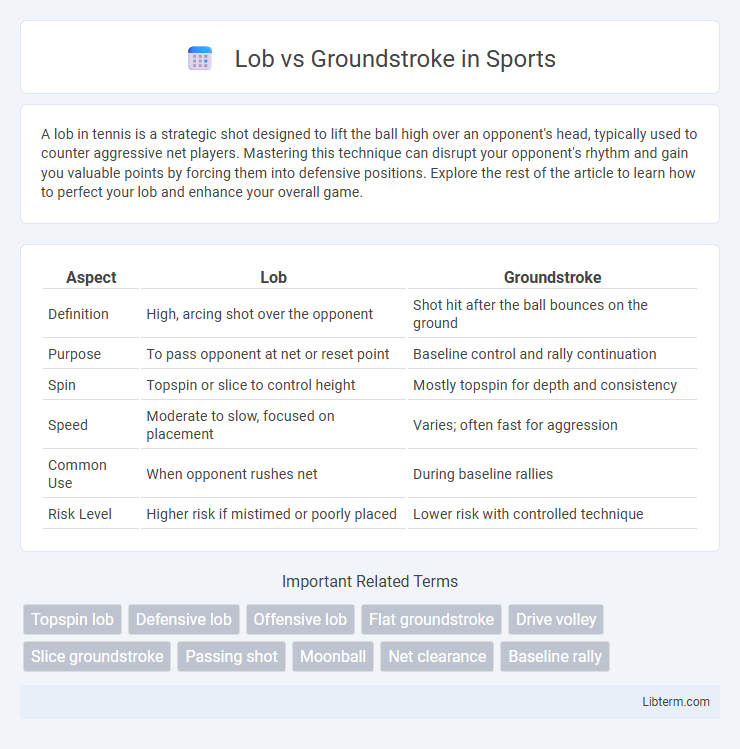A lob in tennis is a strategic shot designed to lift the ball high over an opponent's head, typically used to counter aggressive net players. Mastering this technique can disrupt your opponent's rhythm and gain you valuable points by forcing them into defensive positions. Explore the rest of the article to learn how to perfect your lob and enhance your overall game.
Table of Comparison
| Aspect | Lob | Groundstroke |
|---|---|---|
| Definition | High, arcing shot over the opponent | Shot hit after the ball bounces on the ground |
| Purpose | To pass opponent at net or reset point | Baseline control and rally continuation |
| Spin | Topspin or slice to control height | Mostly topspin for depth and consistency |
| Speed | Moderate to slow, focused on placement | Varies; often fast for aggression |
| Common Use | When opponent rushes net | During baseline rallies |
| Risk Level | Higher risk if mistimed or poorly placed | Lower risk with controlled technique |
Understanding the Basics: Lob vs Groundstroke
A lob in tennis is a high, arcing shot designed to clear an opponent positioned near the net, creating space and gaining time to reset the point. A groundstroke, by contrast, is a fundamental shot hit after the ball bounces, typically executed with topspin to control depth and pace from the baseline. Mastery of both techniques enhances court coverage and strategic play by balancing offensive and defensive tactics.
Key Differences Between Lobs and Groundstrokes
Lobs are high, arcing shots designed to clear opponents at the net, forcing them to move back, while groundstrokes are low, powerful shots hit after the ball bounces, aiming to maintain baseline control. Lobs require precise height and depth control to avoid easy volleys, contrasting with groundstrokes that emphasize speed, spin, and placement for rally dominance. The tactical use of lobs disrupts net play, whereas groundstrokes build offensive pressure through consistent, aggressive hitting.
When to Use a Lob in Your Game
Using a lob is strategic when your opponent is positioned close to the net, creating an opportunity to send the ball high and deep into their court, forcing them to retreat. Executing a lob is effective during defensive situations to buy time and reset the point or as an offensive tactic to catch aggressive net players off guard. Timing lobs precisely can exploit opponents' weak overhead shots and open up the court for your next play.
The Role of Groundstrokes in Tennis Strategy
Groundstrokes serve as the backbone of tennis strategy, providing consistent baseline control and enabling players to dictate rally pace with forehand and backhand shots. Effective groundstrokes generate depth and spin, forcing opponents into defensive positions and setting up offensive opportunities. Mastery of groundstrokes improves court coverage and positions players to anticipate and counter lobs and other tactical shots.
Mechanics and Technique: Perfecting the Lob
Perfecting the lob requires precise racket angle control and a smooth, upward swing motion to generate sufficient loft and distance over the opponent. Key mechanics involve using a relaxed grip with a slightly open racket face and engaging the shoulder and wrist for a fluid follow-through. Mastering timing and ball contact height enhances consistency and accuracy, distinguishing effective lobs from groundstrokes that rely on forward, flat or topspin strokes for speed and low ball trajectory.
Mastering Groundstroke Fundamentals
Mastering groundstroke fundamentals is essential for consistent baseline play, as groundstrokes generate powerful and accurate shots that control rallies. Emphasizing proper footwork, grip, and stroke mechanics improves precision and spin, enabling players to dictate the pace and placement on both forehand and backhand sides. Developing reliable groundstrokes reduces unforced errors and sets up opportunities for offensive tactics or defensive lobs during extended exchanges.
Common Mistakes: Lobs vs Groundstrokes
Common mistakes in lobs and groundstrokes often include misjudging distance and height, leading to ineffective shots that either sail too long or fall short. Players frequently fail to generate the proper spin or pace on groundstrokes, causing reduced control and accuracy. In contrast, improper technique on lobs may result in shots lacking sufficient arc, making them easy for opponents to attack.
Training Drills for Better Lobs and Groundstrokes
Training drills for better lobs focus on improving touch, angle control, and depth, such as practicing high-arcing shots over a partner or targeting specific backcourt zones during rally simulations. Groundstroke drills emphasize consistent timing, footwork, and stroke mechanics, using repetitive forehand and backhand sequences against a wall or with a ball machine to enhance accuracy and power. Combining these drills with situational play scenarios strengthens strategic shot selection and overall court awareness.
Choosing the Right Shot: Lob or Groundstroke?
Choosing the right shot between a lob and a groundstroke depends on positioning and opponent's location. Use a lob to send the ball high and deep over an approaching opponent, forcing them to retreat and resetting the rally. Opt for a groundstroke when aiming to maintain aggressive pressure with controlled, low shots that keep the ball in play and target opponent weaknesses.
Advanced Tips to Elevate Your Lob and Groundstroke Skills
Mastering advanced lob techniques involves perfecting the height and depth of your shot to outmaneuver opponents and create strategic court space, emphasizing topspin for controlled descent. Enhancing groundstroke precision requires optimizing footwork, stroke mechanics, and timing to generate power and consistency, with a focus on targeting opponent's weak spots and maintaining rally tempo. Incorporating varied spin and shot placement in both lob and groundstroke elevates gameplay by disrupting opponent rhythm and increasing scoring opportunities.
Lob Infographic

 libterm.com
libterm.com